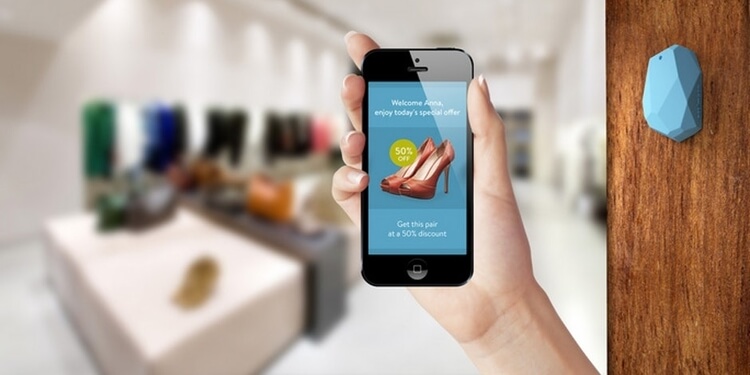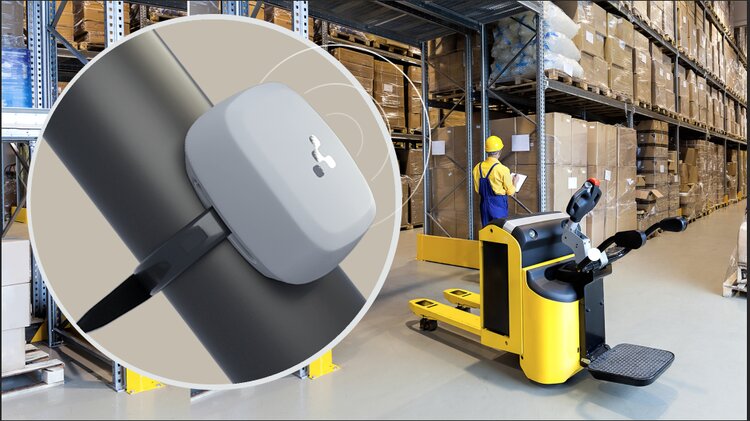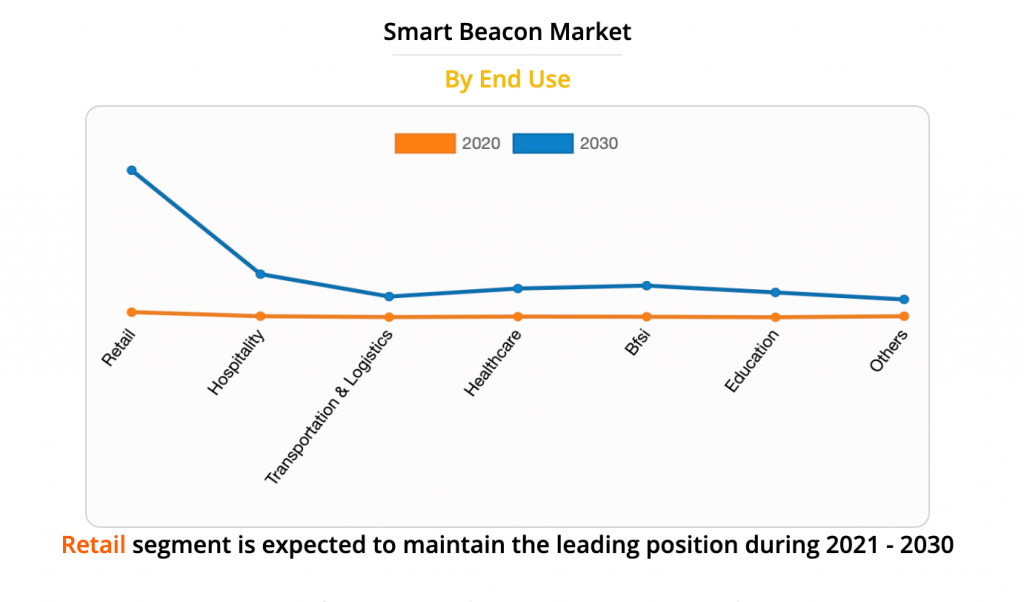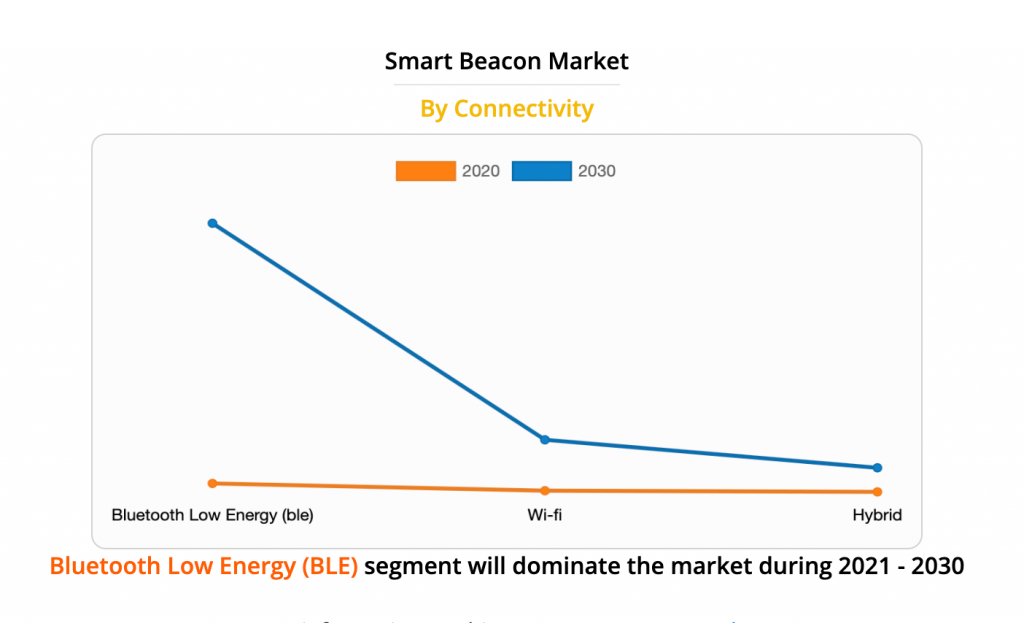Beacon technology is nothing new. It has come a long way since 2013, when Apple first introduced iBeacon technology. Today, smart bluetooth beacons are used in many industries around the world – and demand is rising to record levels.
According to a new research report, the global smart beacon market generated more than $3 billion in 2020, and is expected to reach a whopping $103.94 billion by 2030, growing at a CAGR of 37.70% from 2021 to 2030.
But what has caused this rise in demand? What are the market trends? And what new opportunities are there for businesses with apps? Read on to find out more.
What is beacon technology?
Smart beacons, also known as ‘bluetooth beacons’ ‘BLE beacons’, or just ‘beacons’, are small, wireless bluetooth device that transmit a signal that other bluetooth devices such as smartphones can ‘see’. Beacon devices don’t transmit random signals. It’s transmitting a unique ID number that tells the listening device which beacon it’s next to. When in range of a beacon, the smartphone app will read the beacon data, see what action is assigned to the data and perform the action.
How does beacon technology work?
The most common use of beacon technology is for proximity marketing. It can be simple, such as showing an app user a notification with a coupon for a product the user is close to, or displaying in-app content with a description about an event nearby. Or it can be complex, such as calculating the user’s location based on their proximity to a beacon.
For example, when a retailer installs beacons in their shop, they all have unique IDs registered to their dedicated app. The ID can trigger the app to perform any action the retailer has assigned to it. Or be used to gather user analytics to understand how to optimize a specific space.
Many businesses use beacon devices in conjunction with geofencing software to build their location targeting campaigns. You can find out more about this in this handy guide. Want to get started? PlotProjects is the industry-leading geolocation platform. Our technology allows mobile apps to offer location-based notifications and experiences to their users. Contact us today to find out more.
What is beacon – iBeacons, smart beacons and other terms explained
There are various types of beacons technology.
By standard type, the market is divided into iBeacon, Eddystone and others. The term iBeacon, smart beacons and beacon are often used interchangeably, however iBeacon is the term for Apple’s beacon technology while Eddystone is the name for Google’s, both of which are compatible with mobile apps running on both iOS and Android.
In terms of connectivity, this is segregated into Bluetooth low energy (BLE), Wi-Fi and hybrid. Bluetooth low energy is a form of wireless communication designed for short-range communication. It’s very similar to Wi-Fi in that it allows devices to communicate, however BLE saves battery drain, has a lower range, and transmits less data.
So, BLE beacons as the name suggests are beacons that communicate via Bluetooth low energy technology. The majority of smart beacons used today are BLE beacons.
*To find out more about Apple’s latest iBeacon 2022 updates see here.

Beacon technology in retail
Using beacon technology in retail refers to the use of beacons in the retail industry for proximity marketing. In retail, beacons can reach shoppers with mobile devices who have their Bluetooth enabled and the retailer’s app downloaded on their phone.
We’ll talk more about this in the following sections. You can find out more about how to set up Bluetooth beacons in retail here.
What are the benefits of beacon technology?
A variety of industries including retail, transit, education, hospitality, finance, travel and more all leverage beacon technology to track and communicate with consumers.
The benefits of beacons technology are many, here are just a few:
Proximity marketing
Smart beacons set up in shops, event locations or any public place allow businesses to track the exact location of a consumer at any given time, and deliver targeted notifications for deals, discounts and offers. What’s more, when properly implemented, beacon technology allows businesses to understand more about their users’ behaviour and ultimately use that proximity data to offer a more personalized experience.
Indoor navigation
Smart beacons can be installed in large venues such as hospitals, shopping malls, airports and stadiums, to enable indoor navigation for users of those venues. This can be especially useful in settings such as healthcare, where staff spend many hours of precious time giving directions.
Boost productivity & improve margins
Beacon technology makes it possible for businesses to boost their productivity with data-driven insights. This can help them increase productivity and improve their profit margins. Beacon devices can be used to monitor machines and touchscreens, for staff clocking in and out, or to send push notifications with important updates. This can be especially valuable in factories, manufacturing and other settings.

Other benefits of beacons technology:
- Occupancy monitoring
- Asset tracking
- Contact tracing
- Loyalty programs
- Advanced data gathering
- Mobile ticketing
Why the beacons technology market is booming
Now we’ve had an overview of beacons, let’s talk about why the beacon technology market is booming. Upon the release of iBeacons in 2013 there was plenty of promise, yet beacons didn’t take off as expected. The technology itself has lots of applications and potential, however some functions have only become available as the technology has advanced.
The impact of Covid-19
The Covid-19 pandemic impacted the growth of the smart beacons market due to the lockdown imposed by many governments around the world. What’s more, a disruption in the production of electronics further hampered smart beacon sales. However, smart beacons are now being increasingly utilized, especially in the healthcare industry, to prevent the spread of the virus.
Smart devices & in-store-marketing
A rise in advanced communication technologies, a surge in the adoption of smart devices, and an increase in proximity marketing investment are some of the main drivers of the global beacon market. The adoption of in-store marketing by retailers is increasing at a rapid pace, as is the use of bluetooth-equipped devices such as smartphones and wearable smart watches.
Emerging economies using beacon technology
Furthermore, new hypermarkets, department stores and supermarkets are opening in emerging economies, complete with digital ecosystems that push retailers to use smart beacons and other location-based technology such as geofencing to make their stores smarter.

Smart beacons are a cost-effective solution
The relatively lower price point of Bluetooth-based solutions is also playing a big role in their large-scale adoption in various domains such as indoor navigation, worker security, elderly care, affordable asset tracking, mobile ticketing and much more.
Beacons technology market outlook 2021-2030
According to a recent research report by Allied Market Research, the global smart beacons market is set to experience huge growth, and is expected to reach $103.94 billion by 2030.
A rise in organized retailing such as supermarkets, department stores and hypermarkets is expected to create the most lucrative opportunities during the forecast period. Followed by hospitality, banking, healthcare, education and transportation & logistics.
(images courtesy of Allied Market Research)

Region-wise, the market trends show North America as dominating the market, followed by Europe, Asia-Pacific and LAMEA. This is due to large-scale adoption of the technology, backed by high penetration of mobile devices.
In terms of the market segment, Bluetooth low energy is expected to dominate, with iBeacon leading the way in standard type. By offering, the hardware segment will hold the dominant position throughout the forecast period. However, a lack of technological resources and concerns about privacy and security are noted as market restraints.

To allay privacy concerns when implementing smart beacons or other location-based technology, businesses should look for providers who are committed to user privacy, especially with regards to location data. For instance, the PlotProjects plugin comes with upgraded beacon monitoring, plus an array of industry-leading privacy tools and features.
BLE beacons in public transport
Bluetooth low energy (BLE) has been widely discussed but not much explored in the public transport field. However, with advances in BLE beacon technology together with its surge in demand, some are starting to see it as the perfect solution for mobile ticketing.
BLE beacons allow apps to detect users precisely, even in locations with limited internet access such as underground stations. Another advantage when compared to other types of mobile ticketing is that beacons allow for seamless detection, without the user having to use or even touch their smartphone.
One such mobile ticketing system is called ‘Be In-Be Out’ (BIBO) which is gaining attention and is being tested in several markets, but has not yet seen a large-scale roll out.
What is Be In-Be Out (BIBO)?
With ‘Be In-Be Out’ (BIBO), BLE beacons can determine exactly when a traveller enters and exits a station or a public transport vehicle. This is similar to the ‘check in-check out’ system, however with BIBO the user doesn’t have to perform any manual actions or interact with any ticketing points. Using smart beacons, the operator can easily calculate how long the user was using the service, then calculate the fare based on the best available rate at the end of the day.
Currently, there are no public transport agencies implementing this system, but it is being explored. Chiltern Railways tested it back in 2016 and Wolfgang Narzt et al proposed a ‘be-in/be-out’ ticketing system for public transport using BLE technology back in 2015. China is using NFC on public transport (without bluetooth). While its adoption in The Netherlands was researched by Delft University in 2017.

BLE beacons for mobile ticketing
Due to the rising popularity of beacons technology along with the surge in the use of Bluetooth-enabled smart devices, low energy beacons could offer an effective and feasible solution for agencies looking for the next innovations in public transport.
This cost-effective technology has many advantages, including increased flexibility, precise tracking of user location, easy integration into transport networks, and a seamless, enjoyable experience for the user. Helpful route updates or navigation alerts are all made possible, along with additional support for riders with disabilities or impairments.
Beacons technology also opens up exciting opportunities for transit agencies to partner with retailers to send exclusive location-based deals and offers. Or to put beacons to good fun with gamification, transforming a boring commute! The doors are definitely open for transit agencies to implement low energy beacon technologies, to not only communicate with and understand their users, but to improve both user and operator experience.
Interested in using beacons technology in your app?
Beacon technology is a powerful and cost-effective way to drive sales for businesses both big and small. If you need help getting started with beacons and geofencing, or you want to find out more about how our geofencing platform can drive results for your business, contact PlotProjects today.
What’s more, our PlotRewards API lets you offer your app users all the latest deals and discount in their local area.
You can try our demo app for free, or download one of our customer’s apps to see how it works. Don’t have an app? No problem. We can create a custom geofencing app using the PlotProjects technology.
